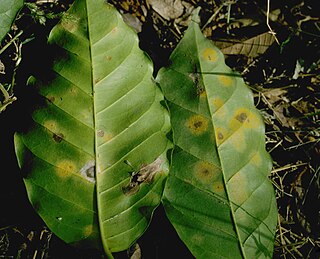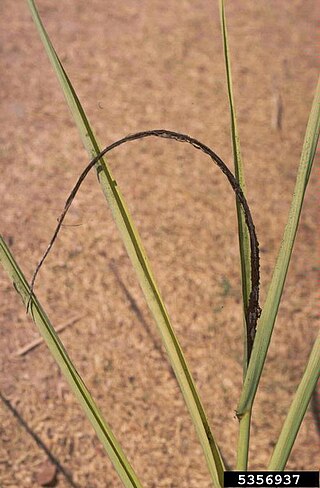
Botrytis cinerea is a necrotrophic fungus that affects many plant species, although its most notable hosts may be wine grapes. In viticulture, it is commonly known as "botrytis bunch rot"; in horticulture, it is usually called "grey mould" or "gray mold".
Fungicides are pesticides used to kill parasitic fungi or their spores. Fungi can cause serious damage in agriculture, resulting in critical losses of yield, quality, and profit. Fungicides are used both in agriculture and to fight fungal infections in animals. Fungicides are also used to control oomycetes, which are not taxonomically/genetically fungi, although sharing similar methods of infecting plants. Fungicides can either be contact, translaminar or systemic. Contact fungicides are not taken up into the plant tissue and protect only the plant where the spray is deposited. Translaminar fungicides redistribute the fungicide from the upper, sprayed leaf surface to the lower, unsprayed surface. Systemic fungicides are taken up and redistributed through the xylem vessels. Few fungicides move to all parts of a plant. Some are locally systemic, and some move upward. Most fungicides that can be bought retail are sold in liquid form, the active ingredient being present at 0.08% in weaker concentrates, and as high as 0.5% for more potent fungicides. Fungicides in powdered form are usually around 90% sulfur.

Black sigatoka is a leaf-spot disease of banana plants caused by the ascomycete fungus Mycosphaerella fijiensis (Morelet), also known as black leaf streak. It was discovered in 1963 and named for its similarities with yellow Sigatoka, which is caused by Mycosphaerella musicola (Mulder), which was itself named after the Sigatoka Valley in Fiji. In the same valley an outbreak of this disease reached epidemic proportions from 1912 to 1923.

Fusarium wilt is a common vascular wilt fungal disease, exhibiting symptoms similar to Verticillium wilt. This disease has been investigated extensively since the early years of this century. The pathogen that causes Fusarium wilt is Fusarium oxysporum. The species is further divided into formae speciales based on host plant.

A leaf spot is a limited, discoloured, diseased area of a leaf that is caused by fungal, bacterial or viral plant diseases, or by injuries from nematodes, insects, environmental factors, toxicity or herbicides. These discoloured spots or lesions often have a centre of necrosis. Symptoms can overlap across causal agents, however differing signs and symptoms of certain pathogens can lead to the diagnosis of the type of leaf spot disease. Prolonged wet and humid conditions promote leaf spot disease and most pathogens are spread by wind, splashing rain or irrigation that carry the disease to other leaves.

Magnaporthe grisea, also known as rice blast fungus, rice rotten neck, rice seedling blight, blast of rice, oval leaf spot of graminea, pitting disease, ryegrass blast, Johnson spot, neck blast, wheat blast and Imochi (稲熱), is a plant-pathogenic fungus and model organism that causes a serious disease affecting rice. It is now known that M. grisea consists of a cryptic species complex containing at least two biological species that have clear genetic differences and do not interbreed. Complex members isolated from Digitaria have been more narrowly defined as M. grisea. The remaining members of the complex isolated from rice and a variety of other hosts have been renamed Magnaporthe oryzae, within the same M. grisea complex. Confusion on which of these two names to use for the rice blast pathogen remains, as both are now used by different authors.

Hemileia vastatrix is a multicellular basidiomycete fungus of the order Pucciniales that causes coffee leaf rust (CLR), a disease affecting the coffee plant. Coffee serves as the obligate host of coffee rust, that is, the rust must have access to and come into physical contact with coffee in order to survive.

Sugarcane smut is a fungal disease of sugarcane caused by the fungus Sporisorium scitamineum. The disease is known as culmicolous, which describes the outgrowth of fungus of the stalk on the cane. It attacks several sugarcane species and has been reported to occur on a few other grass species as well, but not to a critical amount. The most recognizable characteristic of this disease is a black or gray growth that is referred to as a "smut whip". Resistance to sugarcane smut is the best course of action for management, but also the use of disease free seed is important. On smaller scale operations treatments using hot water and removing infected plants can be effective. The main mode of spore dispersal is the wind but the disease also spreads through the use of infected cuttings. Sugarcane smut is a devastating disease in sugarcane growing areas globally.

Cochliobolus miyabeanus is a fungus that causes brown spot disease in rice.

Rhizoctonia solani is a species of fungus in the order Cantharellales. Basidiocarps are thin, effused, and web-like, but the fungus is more typically encountered in its anamorphic state, as hyphae and sclerotia. The name Rhizoctonia solani is currently applied to a complex of related species that await further research. In its wide sense, Rhizoctonia solani is a facultative plant pathogen with a wide host range and worldwide distribution. It causes various plant diseases such as root rot, damping off, and wire stem. It can also form mycorrhizal associations with orchids.

Alternaria alternata is a fungus causing leaf spots, rots, and blights on many plant parts, and other diseases. It is an opportunistic pathogen on over 380 host species of plant.

Pyrenophora tritici-repentis (teleomorph) and Drechslera tritici-repentis (anamorph) is a necrotrophic plant pathogen of fungal origin, phylum Ascomycota. The pathogen causes a disease originally named yellow spot but now commonly called tan spot, yellow leaf spot, yellow leaf blotch or helminthosporiosis. At least eight races of the pathogen are known to occur based on their virulence on a wheat differential set.

Zymoseptoria tritici, synonyms Septoria tritici, Mycosphaerella graminicola, is a species of filamentous fungus, an ascomycete in the family Mycosphaerellaceae. It is a wheat plant pathogen causing septoria leaf blotch that is difficult to control due to resistance to multiple fungicides. The pathogen today causes one of the most important diseases of wheat.
Sclerophthora macrospora is a protist plant pathogen of the class Oomycota. It causes downy mildew on a vast number of cereal crops including oats, rice, maize, and wheat as well as varieties of turf grass. The common names of the diseases associated with Sclerophthora macrospora include “crazy top disease” on maize and yellow tuft disease on turf grass. The disease is present all over the world, but it is especially persistent in Europe.

Taphrina deformans is a fungus and plant pathogen, and a causal agent[s] of peach leaf curl. Peach trees infected with T. deformans will experience leaf puckering and distortion, acquiring a characteristic downward and inward curl. Leaves will also undergo chlorosis, turning a pale green or yellow, and later show a red or purple tint. Fruit can either drop prematurely or show surface distortions. Severe infection can also produce lesions on the flowers. The host tree will experience defoliation if the leaves are badly diseased. If a seedling is severely infected, it may die. Almond trees display similar symptoms.

Verticillium dahliae is a fungal plant pathogen. It causes verticillium wilt in many plant species, causing leaves to curl and discolor. It may cause death in some plants. Over 400 plant species are affected by Verticillium complex.
Alternaria carthami is a necrotrophic plant pathogen of safflower. The fungus is in the order Pleosporales and family Pleosporaceae. It was first isolated in India, has spread globally and can have devastating effects on safflower yield, and resultant oilseed production. A. carthami is known to be seed-borne and appears as irregular brown lesions on safflower leaves and stems.
Curvularia trifolii is a plant pathogen.

Plant disease resistance protects plants from pathogens in two ways: by pre-formed structures and chemicals, and by infection-induced responses of the immune system. Relative to a susceptible plant, disease resistance is the reduction of pathogen growth on or in the plant, while the term disease tolerance describes plants that exhibit little disease damage despite substantial pathogen levels. Disease outcome is determined by the three-way interaction of the pathogen, the plant and the environmental conditions.
Bacterial leaf streak (BLS), also known as black chaff, is a common bacterial disease of wheat. The disease is caused by the bacterial species Xanthomonas translucens pv. undulosa. The pathogen is found globally, but is a primary problem in the US in the lower mid-south and can reduce yields by up to 40 percent.[6] BLS is primarily seed-borne and survives in and on the seed, but may also survive in crop residue in the soil in the off-season. During the growing season, the bacteria may transfer from plant to plant by contact, but it is primarily spread by rain, wind and insect contact. The bacteria thrives in moist environments, and produces a cream to yellow bacterial ooze, which, when dry, appears light colored and scale-like, resulting in a streak on the leaves. The invasion of the head of wheat causes bands of necrotic tissue on the awns, which is called Black Chaff.[14] The disease is not easily managed, as there are no pesticides on the market for treatment of the infection. There are some resistant cultivars available, but no seed treatment exists. Some integrated pest management (IPM) techniques may be used to assist with preventing infection although, none will completely prevent the disease.[2]














